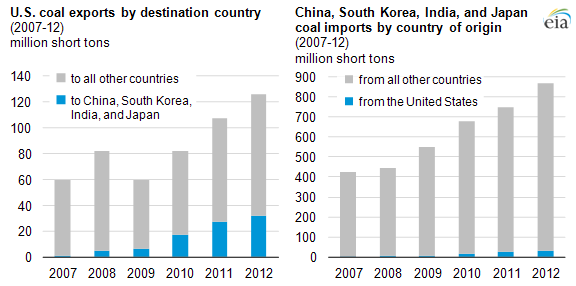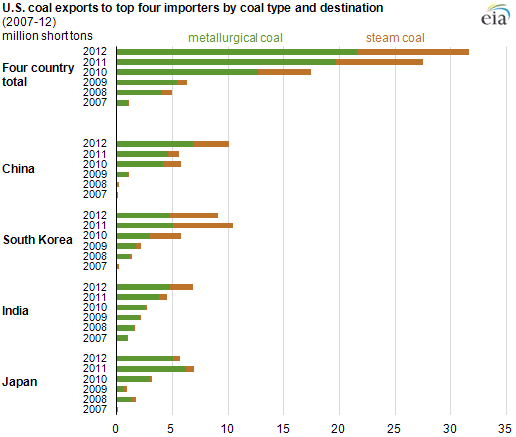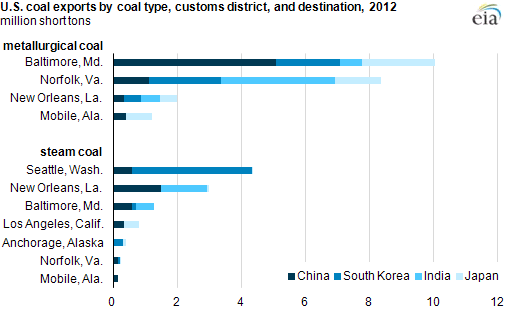
25% of U.S. coal exports go to Asia, but remain a small share of Asia’s total coal imports

U.S. coal exports have made steady inroads into the Asian market since 2007. Almost all the U.S. coal exported to Asia went to the world's top four coal importers: China, Japan, India, and South Korea. Asia's share of total U.S. coal exports increased from 2% in 2007 to 25% in 2012. While U.S. coal has also been gaining market share in Asia, it provided less than 4% of Asia's coal imports in 2012, and less than 1% of total coal consumed by the four large Asian importers.
Growing coal exports to Asia contributed to the all-time monthly record for total U.S. coal exports in March, accounting for more than half of the total growth over March 2012 exports.
Both structural and cyclical forces have driven the growth of U.S. coal exports to Asia in the past five years. Companies in key parts of the U.S. coal supply chain—both producers and railways—have increased sales to Asia because of rising Asian coal demand, overall strong export prices, and lower U.S. consumption of coal to produce electric power. Further, occasional factors such as supply disruptions in other coal-exporting countries have also provided a temporary boost to U.S. coal exports. For example, exports to China of U.S. metallurgical coal during the first quarter of 2013 were more than double their 2012 level, largely because of higher metallurgical coal demand from China against the backdrop of lower coking coal supply from Mongolia to China resulting from contract disputes.
Coal exports to China and South Korea have grown particularly fast, although exports to India and Japan have also grown. Metallurgical coal accounted for two-thirds of the growth in the past five years, and steam coal accounted for one-third. While metallurgical coal export growth has been more evenly distributed among the four countries, steam coal export growth has been driven mostly by South Korea and China.

Nearly all metallurgical coal exports to Asia in 2012 were exported from ports on the East coast and the Gulf of Mexico. However, most U.S. exports of steam coal to Asia were exported from ports on the West Coast and the Gulf of Mexico. In the past few years, steam coal exports exiting through the Pacific Northwest, a key outlet for Powder River Basin coal, have been primarily destined for South Korea.

Despite recent growth, U.S. coal exports remain a relatively small source of supply to the Asian coal markets. It faces strong competition from other suppliers to the region, especially Indonesia, Australia, South Africa, and Russia in the steam coal market and Australia, Canada, and Russia in the metallurgical coal market. In the past two years, Mongolia has become a major supplier of coking coal to China, adding to the competition in the metallurgical coal market. Future growth of U.S. coal exports to Asia will depend upon the pace of Asian coal demand growth; expansion of U.S. port infrastructure, especially on the West Coast; coal pricing in Asia; and the cost of U.S. coal landed in Asia compared to that offered by other major coal exporters.
Tags: China, coal, exports/imports, India, international, Japan, South Korea